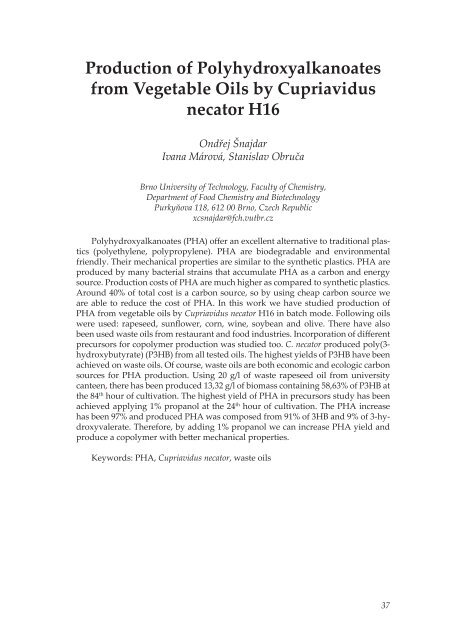Sborník abstraktů 2010 - Fakulta chemická - Vysoké učení technické ...
Sborník abstraktů 2010 - Fakulta chemická - Vysoké učení technické ...
Sborník abstraktů 2010 - Fakulta chemická - Vysoké učení technické ...
You also want an ePaper? Increase the reach of your titles
YUMPU automatically turns print PDFs into web optimized ePapers that Google loves.
Production of Polyhydroxyalkanoates<br />
from Vegetable Oils by Cupriavidus<br />
necator H16<br />
Ondřej Šnajdar<br />
Ivana Márová, Stanislav Obruča<br />
Brno University of Technology, Faculty of Chemistry,<br />
Department of Food Chemistry and Biotechnology<br />
Purkyňova 118, 612 00 Brno, Czech Republic<br />
xcsnajdar@fch.vutbr.cz<br />
Polyhydroxyalkanoates (PHA) offer an excellent alternative to traditional plastics<br />
(polyethylene, polypropylene). PHA are biodegradable and environmental<br />
friendly. Their mechanical properties are similar to the synthetic plastics. PHA are<br />
produced by many bacterial strains that accumulate PHA as a carbon and energy<br />
source. Production costs of PHA are much higher as compared to synthetic plastics.<br />
Around 40% of total cost is a carbon source, so by using cheap carbon source we<br />
are able to reduce the cost of PHA. In this work we have studied production of<br />
PHA from vegetable oils by Cupriavidus necator H16 in batch mode. Following oils<br />
were used: rapeseed, sunflower, corn, wine, soybean and olive. There have also<br />
been used waste oils from restaurant and food industries. Incorporation of different<br />
precursors for copolymer production was studied too. C. necator produced poly(3hydroxybutyrate)<br />
(P3HB) from all tested oils. The highest yields of P3HB have been<br />
achieved on waste oils. Of course, waste oils are both economic and ecologic carbon<br />
sources for PHA production. Using 20 g/l of waste rapeseed oil from university<br />
canteen, there has been produced 13,32 g/l of biomass containing 58,63% of P3HB at<br />
the 84 th hour of cultivation. The highest yield of PHA in precursors study has been<br />
achieved applying 1% propanol at the 24 th hour of cultivation. The PHA increase<br />
has been 97% and produced PHA was composed from 91% of 3HB and 9% of 3-hydroxyvalerate.<br />
Therefore, by adding 1% propanol we can increase PHA yield and<br />
produce a copolymer with better mechanical properties.<br />
Keywords: PHA, Cupriavidus necator, waste oils<br />
37

















